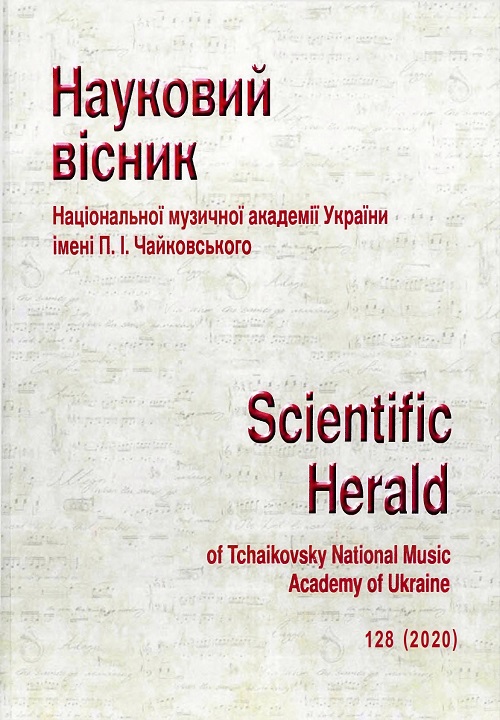Organ Poem in the Music of European Composers: Modern Projections of the Genre
DOI:
https://doi.org/10.31318/2522-4190.2020.128.215196Keywords:
instrumental poem, organ poem, K. Ferrari’s work, V. Guba’s work, organ works of Ukrainian composers, organ works of Italian composersAbstract
Relevance of study. The features of the modern poem for the organ are considered on the example of “Edith Stein” by Carlotta Ferrari (Italy) and “Voice of Memory” by Vladimir Guba (Ukraine). The relevance of the topic caused by the interest in the poem genre for the organ by both composers and performers. At the same time there is lack of musicology literature on this issue, which determines the need for genre-style attribution of organ works with a similar name.
Main Objective. The purpose of the article is to determine the genre parameters of a poem for organ based on the example of works by composers of the second half of the 20th and beginning of the 21st centuries. The objectives of the study are to determine the prerequisites for the formation of a poem for an organ as an independent genre unit and to compare the strategies of reading the genre by composers of Western European and Eastern European cultural formations.
Methodology. The research methodology is based on the use of: the historical-typological method in determining the prerequisites for the formation of the poem genre for the organ and the historical stages of its development, the structural analysis method — in determining the form of works, the method of genre-style analysis — in determining additional genre-style parameters of poems, the semantic method analysis — in determining the features of the software component, as well as the method of comparative analysis when comparing the poems of K. Ferrari and V. Guba.
Results/Finding and Conclusions. It is established that a poem for an organ is a species variety of a romantic instrumental poem, which affected the absence of clear boundaries, instability and potential variability of the poetic genre. It was revealed that the dynamics of the development of the organ poem demonstrates a gradual increase in the influence of the traditions of ancient organ music on it. It has been determined that poems for an organ of the turn of the twentieth — early 21 century demonstrate a free interpretation by composers of a genre invariant with a general tendency to mix genre traditions of romantic and baroque music. The poem “Edith Stein” by C. Ferrari and “The Voice of Memory” by V. Guba reveal similarities in a number of parameters (program, picturesqueness, contrast and dynamics of internal processes, monothemаtism, etc.). It was established that it was the difference in the mental prerequisites of the composers of the West European and East European cultural formations, expressed in the dissimilarity of the interpretation of the organ timbre, that influenced the principles of reading the genre. The religious programmatic nature of the poem by C. Ferrari became the reason for using a choral quote placed in the framework of Baroque genres (preludes, passacalia, small polyphonic cycle) and updated by means of repetitive techniques. Deprived of religious connotations, V. Guba’s poem is solved in a traditionally romantic way: while maintaining the main parameters of the genre, the degree of “emotional temperature” rises in it, which turns the opus into a lyrical and dramatic narrative.
Downloads
References
Abdulina, G. V. (2005), Passakalia in instrumental music of the second half of the twentieth century [Passakalija v instrumental’noj muzyke vtoroj poloviny XX veka]. Abstract of the PhD diss. Russian State Pedagogical University named after A. I. Herzen. 24 p. [in Russian]
Andrushchak, T. S (2008), Memorial in Russian music of the last third of the twentieth century: to the study of the phenomenon [Memorial’nost’ v otechestvennoj muzyke poslednej treti XX veka: k issledovaniju fenomena]. Abstract of the PhD diss. State educational institution of higher professional education “Astrakhan State Conservatory (Institute)”. 24 p. [in Russian]
Apallonova, I. V. (2009), Genre canon of a symphonic poem and its refraction in instrumental music of the XIX — early XX centuries [Zhanrovyj kanon simfonicheskoj pojemy i ego prelomlenie v instrumental’noj muzyke XIX — nachala XX veka]. 29 p. [in Russian]
Kalenichenko, A. (2015), Ukrainian symphonic poem of the twentieth century: historical profile [Ukrainska symfonichna poema XX stolittia: istorychnyi profil]. Art studies [Studii mystetstvoznavchi]. Vol. 3б рp. 88–95. [in Ukrainian]
Krivitskaya, Ye. (2008), France [Francija]. From the history of world organ culture of the 16–20th centuries. [Iz istorii mirovoj organnoj kul’tury XVI–XX vekov], рp. 562–592. [in Russian].
Kooman, K. Carlotta Ferrari — Edith Stein (Poema sinfonico) (2005) for organ (2014). Available at: https://www.youtube.com/watch?v=s7Ywh8bvl2c (accessed: 23.05.2020)
Sokolov, A. (1994). Genre in the context of musical culture [Zhanr v kontekste muzykal’noj kul’tury]. Lobachevsky State University of Nizhny Novgorod. Nizhny Novgorod, 214 p. [in Russian].
Downloads
Published
How to Cite
Issue
Section
License
Our journal abides by the CREATIVE COMMONS copyright rights and permissions for open access journals.
Authors, who are published in this journal, agree to the following conditions:
The authors reserve the right to authorship of the work and pass the first publication right of this work to the journal under the terms of a Creative Commons Attribution License, which allows others to freely distribute the published research with the obligatory reference to the authors of the original work and the first publication of the work in this journal.
The authors have the right to conclude separate supplement agreements that relate to non-exclusive work distribution in the form in which it has been published by the journal (for example, to upload the work to the online storage of the journal or publish it as part of a monograph), provided that the reference to the first publication of the work in this journal is included.




